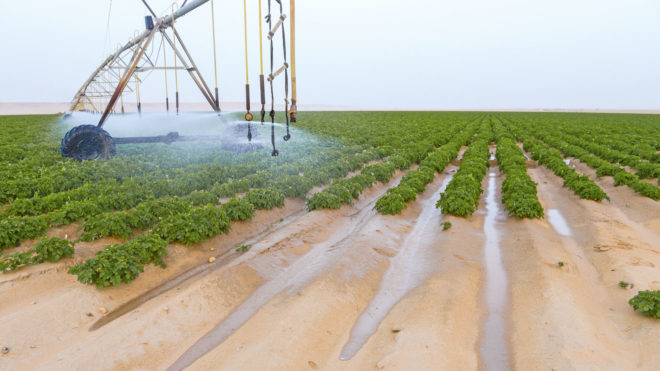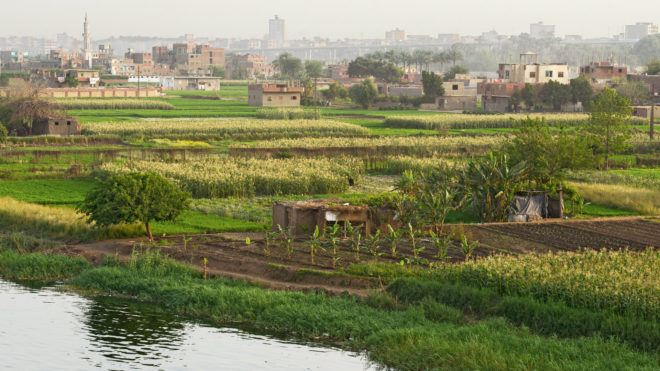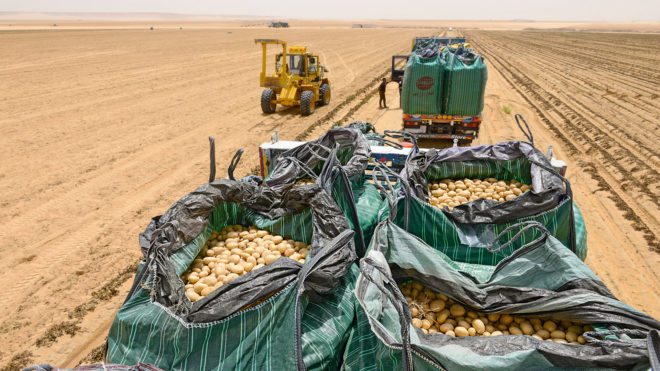The dark embankments extend up to the row of date trees at the edge of the wide field. Some 60 t of compost are fermenting in each row and giving off a strong aroma. “You almost want to eat it.” Taissir Saqr holds a handful up to his nose. Behind him there is a tractor pulling a hay tedder through one of the embankments. The compost must not become hotter than 65 °C, otherwise the microorganisms die. That is why it is regularly turned and watered.
“I look after it as much as I look after my children,” laughs Mr Saqr. The Egyptian Sekem farm produces 8,000 t this way every year.
“The compost is at the heart of our method,” says Angela Hofmann as she casts her gaze over the field. The farming expert has been working on the farm 60 km north-east of Cairo, which was founded by Ibrahim Abouleish, since the early 1980s.
“When we started out, there was nothing but sand here,” she remembers. About 90 % of Egypt is desert, but Mr Abouleish and his colleagues have made it bloom. Today there is fennel, cumin, mullein, sesame, wheat, eggplants, tomatoes and much more growing on the company’s original farm.
Soil formation with compost

Angela Hofmann is one of the pioneers in the Sekem farm team.
But how can anyone get fertile farmland out of this barren desert? First of all, these pioneers planted a wide belt of trees to provide shade and act as wind breaks. Then they sunk wells, applied silt, cow dung and various organic substances to the soil along with compost, before sowing plants and irrigating them. Initially they flooded the fields. Now a system of pipes supplies sprinklers and an efficient drip irrigation system. “Now we only use half as much water,” says Ms Hofmann.
And so over the years a 30 cm thick layer of humus has built up. At the heart of this is the compost. To begin with, 44-54 t/ha are mixed into the sandy soil once, then around 10 t each season after. Having the right crop rotation and avoiding fields lying fallow is also essential. “Otherwise we’ll quickly end up with a desert here again,” explains Ms Hofmann.
Sekem is now the largest herbal tea producer in Egypt, as well as supplying bakeries across the country with sesame seeds. Contracted farmers across the entire country work 3,000 ha. The company exports herbs and medicinal plants, which it produces according to strict organic guidelines, and in addition operates a manufacturing facility for clothes made of organic cotton from its own fields.
Concrete desert instead of a sea of sand
And yet, where there had been a desert of sand since the beginning of history, there is now a concrete desert. Cairo is growing non-stop and with the mega-metropolis come pollutants: Automotive and industrial exhaust gases, dust and dioxin from illegally incinerated waste. That is why Sekem is investing in an 890 ha new location hundreds of miles away, in the middle of the Libyan desert.

Expensive but efficient: with rotary irrigiation you can plant more densely and use machines on the whole field.
The desert shows off its great diversity in colours and shapes on the long drive there. Then dark piles of compost appear, and behind them you can see the rotary irrigation systems.
“Acquiring the rotary irrigation is expensive, especially since we want to run the pumps on solar energy,” explains farm manager Hany Hassanein. But it has major advantages over a drip irrigation system: There are no pipes in the soil to keep breaking down for a start. It is true that more water is used, but in turn it generates almost twice the yield, because the farm can plant more densely compared to the drip irrigiation system.
People have always grown plants in the desert, in and around the oases. Even today there are self-supporting farms that grow wheat, vegetables, forage crops, pomegranates, oranges or dates on small areas, irrigated from 50-60 m deep wells that several farmers use jointly. These desert farmers flood their fields, since there is not enough money for efficient systems. When they invest, they invest in solar panels for running the pumps in order to save diesel. They don’t maintain a systematic soil structure either. Many of these farms become oversalted or are given up for other reasons, such as a low wheat price.
New farmland
Behind Mr Hassanein, men are walking through the field and pressing seedlings of mint into the wet sand. The undemanding and robust plant is supposed to grow in the field for the first three years. “That’s then followed by legumes for a season, until we can plant medicinal plants or even vegetables.”
And where is the compost? Only a few dark balls in the yellow sand show that the soil has been prepared. Despite that, its full effects are evident. For instance, the compost protects the soil from becoming oversalted, which is a risk when the irrigation is so intensive, because the microorganisms break down salt.

The traditional farming area in the Nile valley is over-used and over-crowded.
Originally, farming in Egypt was predominantly practiced on the alluvial soil of the Nile. However, today this land is increasingly spoiled by development and burdened by sewage flows in the river as well as residue pesticides. A gigantic dam project in Ethiopia on the upper course of the Nile could also mean a water shortage.
The farmed area has already increased by 7 % over the past 10 years and the current military government wants to further expand domestic agriculture. But the only place that can happen is in the desert. That is why the ambitious 1.5 m feddan (630,000 ha) project has been initiated – the feddan, a unit of area still commonly used in the region, is equal to slightly over an acre.

The Sekem farm located 60 km north-east of Cairo produces 8,000 t of compost per year.
The intention is for 630,000 ha of farmland to be developed from the desert and irrigated from wells sunk up to 1,000 m deep into the Nubian Sandstone Aquifer System, one of the largest aquifers in the world.
In the al-Farafra depression for example, large plots of many hundreds of acres are being awarded to investors. They have to bear the high costs of the development themselves.
Potatoes from the desert
The drive takes us along well built roads through the white desert with its enormous limestone sculptures. Art, formed from desert storms and the scorching sun. Semi-trailers with black, 2 t sacks full of potatoes struggle northward on the opposite lane. What was once the tranquil oasis of Farafra has now grown into a bustling centre. Rows of semi-trailers are parked alongside the roads, while combines and trucks full of sacks of dung are rolling along them. Harvest workers, with the traditional kufiya around their heads, wait for work in the shade of the few trees.

Some desert soils offer good conditions for large-scale potato growing.
On the United Farm’s land, the potato harvest is in full swing. For three years the country’s largest producer of potato chips has rented 688 ha here to expand its production amidst the desert sands. Machines and people work early in the morning, so that the potatoes are already on their way north on the trucks by the time it gets hot. Now a tractor is ploughing the residue under the soil and piling up the embankments for the next planting season.
The soil is ideal, which is by no means the case everywhere in the desert.
Ali El Said
“The soil is ideal, which is by no means the case everywhere in the desert.” Quality manager Ali El Said lets the sand trickle through his fingers. “The top 40 cm is sand, which quickly gives off its moisture to the potatoes.” The potatoes are ripe after just three to four months. What’s more, the levelled, light soil provides good conditions for running the rotary irrigation: It slowly and lazily makes circles, covering an area of 50 ha or more in just 24 hours. Nutrients are mixed into the water and crop protection is sprayed on if it is needed.
Sustainable cultivation

View from outer space: Fields with rotary irrigiation in Egypt’s desert.
Potatoes are also grown on the vast farmland area near the United Farm. “The costs here are very high,” explains farm manager Mohamed Gad. Despite this, Daltex, Egypt’s largest potato producer with 400,000 t sold per year, wants to expand cultivation by almost 8,100 ha so as to produce seeds and organic products, mostly for export. Crops are also being grown for export on other desert farms in the 1.5 m feddan project.
But other producers are also growing corn or wheat for the Egyptian market on their land, and the crops on Daltex’s potato fields are also meant for Egypt. So will the project expand food production for the local market? Or will it just open up new sources of foreign currency for big investors?
Use of the Nubian Sandstone Aquifer System is controversial, since it is a non-renewable water resource. But does Egypt have another choice besides using its deserts for farming? The space is there, it just needs to be used sustainably. Ideally by building up a living layer of humus. That helps to save water, stop the soil from becoming oversalted, and absorbs greenhouse gases. Taissir Saqr from the Sekem farm has the compost needed for that.
Sekem – Facts and Figures
- 1977 Dr Ibrahim Abouleish establishes the first Sekem farm 60 km east of Cairo on 70 ha of desert.
- 200 ha – the size of the farm today.
- 3,000 ha of contract farming by certified companies.
- 900 ha – the new site in the western desert where Sekem is tapping into unspoiled land.
- 8,000 t of compost is produced on the original farm every year to keep the currently farmed land fertile and to tap into new acreage.
- 40-50 t/ha of compost is mixed with the desert sand once, followed by 10 t per season.
- Alongside farming, the Sekem Holding which was founded in the year 2000 processes herbs, spices and pharmaceutical plants. It also produces textiles using organic cotton, exports fruit and vegetables and undertakes organic food production.
- With 600-700 m tea bags produced a year using herbs from its own fields, Sekem is the biggest tea producer in Egypt.

